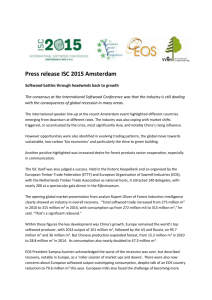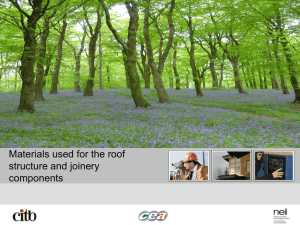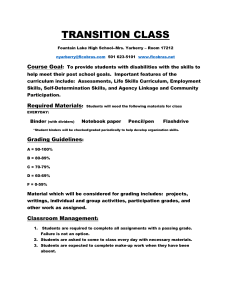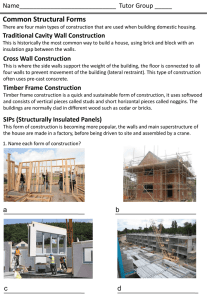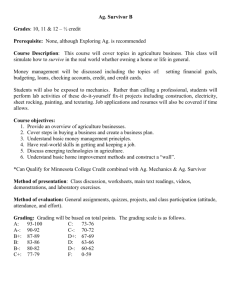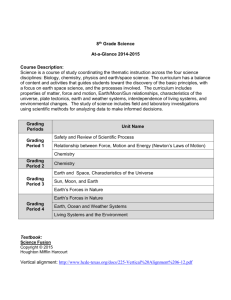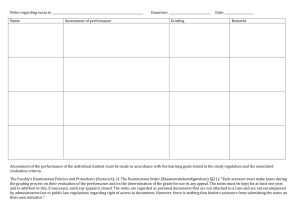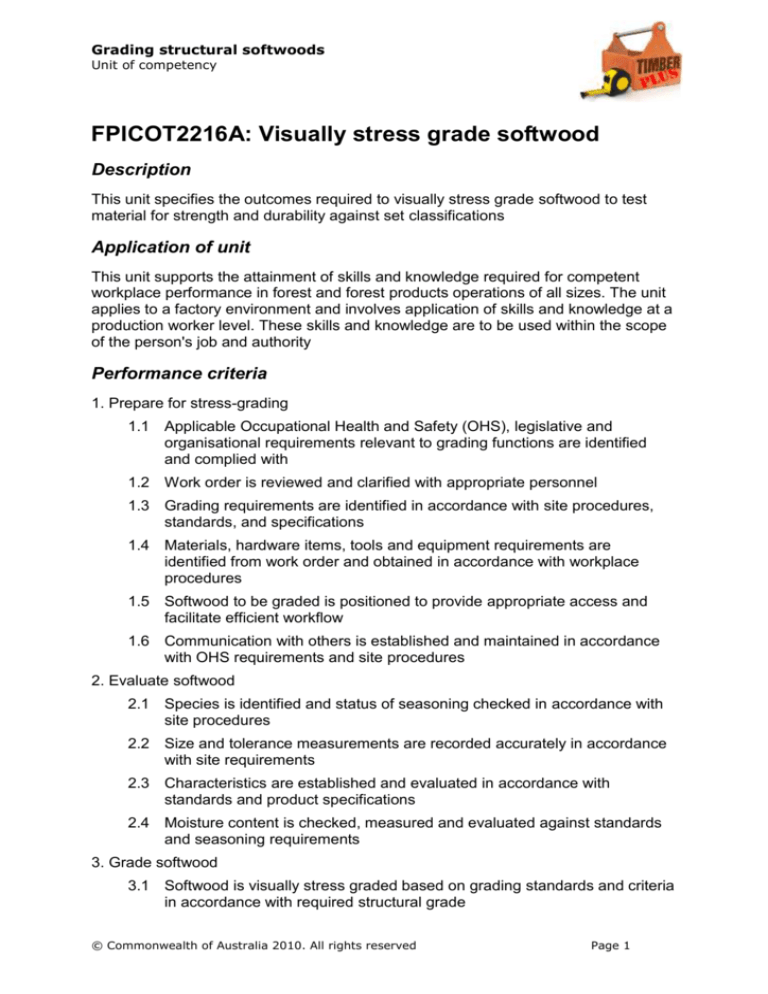
Grading structural softwoods
Unit of competency
FPICOT2216A: Visually stress grade softwood
Description
This unit specifies the outcomes required to visually stress grade softwood to test
material for strength and durability against set classifications
Application of unit
This unit supports the attainment of skills and knowledge required for competent
workplace performance in forest and forest products operations of all sizes. The unit
applies to a factory environment and involves application of skills and knowledge at a
production worker level. These skills and knowledge are to be used within the scope
of the person's job and authority
Performance criteria
1. Prepare for stress-grading
1.1 Applicable Occupational Health and Safety (OHS), legislative and
organisational requirements relevant to grading functions are identified
and complied with
1.2 Work order is reviewed and clarified with appropriate personnel
1.3 Grading requirements are identified in accordance with site procedures,
standards, and specifications
1.4 Materials, hardware items, tools and equipment requirements are
identified from work order and obtained in accordance with workplace
procedures
1.5 Softwood to be graded is positioned to provide appropriate access and
facilitate efficient workflow
1.6 Communication with others is established and maintained in accordance
with OHS requirements and site procedures
2. Evaluate softwood
2.1 Species is identified and status of seasoning checked in accordance with
site procedures
2.2 Size and tolerance measurements are recorded accurately in accordance
with site requirements
2.3 Characteristics are established and evaluated in accordance with
standards and product specifications
2.4 Moisture content is checked, measured and evaluated against standards
and seasoning requirements
3. Grade softwood
3.1 Softwood is visually stress graded based on grading standards and criteria
in accordance with required structural grade
© Commonwealth of Australia 2010. All rights reserved
Page 1
Grading structural softwoods
Unit of competency
3.2 Characteristics which have the greatest limiting effect on the grade are
diagnosed and checked
3.3 Appearance criteria is assessed and timber marked and segregated in
accordance with site procedures
3.4 Results of grading are recorded and reported in accordance with
workplace procedures
Key competencies
The seven key competencies represent generic skills considered necessary for
effective participation by an individual in the workplace
Performance Level 1 at this level, the candidate is required to undertake tasks
effectively
Performance Level 2 at this level, the candidate is required to manage tasks
Performance Level 3 at this level, the candidate is required to use concepts for
evaluating and reshaping tasks
Key Competency
Example of Application
Performance
Level
Communicating ideas
and information
By communicating in simple language to
confirm work requirements, convey
information and requests to colleagues,
and report and record outcomes for
stress-grading softwood
1
Collecting analysing and
organising information
By collecting, organising and
understanding information required to
undertake stress-grading of softwood
2
Planning and organising
activities
By organising work activities in the
correct sequence for stress-grading of
softwood to be completed within the
designated timeframes
2
Working with others and
in teams
By using effective communication and
interpersonal techniques with colleagues
and others to maximise confidence,
satisfaction and productivity during the
process of stress-grading softwood
1
Using mathematical
ideas and techniques
By calculating quantities, assessing
moisture content and stress
measurement
1
Solving problems
By establishing effective grading
processes which anticipate likely
problems to avoid wastage and downtime
1
© Commonwealth of Australia 2010. All rights reserved
Page 2
Grading structural softwoods
Unit of competency
Using technology
By using technology to record and report
grading outcomes
1
Skills and Knowledge
Required skills include:
comply with legislation, regulations, standards, codes of practice and
established safe practices and procedures when visually stress-grading
softwood
review and accurately identify work requirements
identify and apply correct methods and procedures when preparing, evaluating
and grading softwood
access, identify and apply information relevant to softwood grading
use and maintain relevant tools, machinery and equipment
identify problems, malfunctions and defects, and demonstrate appropriate
response procedures
use effective communication and interpersonal techniques with colleagues and
others
efficiently and safely visually stress grade softwood
accurately locate, record and report information.
Required knowledge and understanding includes:
basic knowledge and understanding of applicable Commonwealth, State or
Territory legislation, regulations, standards and codes of practice relevant to the
full range of processes for stress-grading softwood
organisational and site standards, requirements, policies and procedures for
selecting timber for stress-grading softwood
principles of cultural diversity and access and equity
environmental protection requirements, including the safe disposal of waste
material
established communication channels and protocols
problem identification and resolution
types of tools and equipment and procedures for their use, operation and
maintenance
visual stress-grading techniques
grading markings and standards
methods of visual inspection
characteristics and properties of softwood
© Commonwealth of Australia 2010. All rights reserved
Page 3
Grading structural softwoods
Unit of competency
stress-grading equipment calibration and grade thresholds
storage systems and labelling
procedures for recording and reporting workplace information
appropriate mathematical procedures for estimating and measuring, including
calculating time to complete tasks.
Range statement
The Range Statement relates to the unit of competency as a whole. It allows for
different work environments and situations that may affect performance.
OHS requirements are to be in accordance with Commonwealth, State or Territory
legislation and regulations, and organisational safety policies and procedures.
Requirements may include:
the use of personal protective equipment and clothing
safety equipment
first aid equipment
fire fighting equipment
hazard and risk control
elimination of hazardous materials and substances
manual handling including shifting, lifting and carrying.
Legislative requirements are to be in accordance with applicable legislation from all
levels of government that affect organisational operation. Requirements may include:
award and enterprise agreements
industrial relations
Australian Standards
confidentiality and privacy
OHS
the environment
equal opportunity
anti-discrimination
relevant industry codes of practice
duty of care.
Organisational requirements
may include legal, organisational and site guidelines, policies and procedures
relating to own role and responsibility, quality assurance, procedural manuals,
quality and continuous improvement processes and standards, OHS,
emergency and evacuation, ethical standards, recording and reporting, access
and equity principles and practices, equipment use, maintenance and storage,
environmental management (waste disposal, recycling and re-use guidelines).
© Commonwealth of Australia 2010. All rights reserved
Page 4
Grading structural softwoods
Unit of competency
Appropriate personnel
may include supervisors, suppliers, clients, colleagues and managers.
Grading
is to include visually evaluating material characteristics for classification into
varying strength/structural grades.
Standards
are those contained in Australian Standards and additional requirements
established by the client or producer.
Equipment
may include vernier callipers, profile gauges, moisture meters (resistance and
capacitance), tapes and marking implements.
Softwood
may include native timber species, imported timber species, dressed timber, inthe-rough timber and preservative treated timber. Softwood is non-pored wood,
usually comes from trees with needle like foliage and has a more uniform cell
structure.
Communication
may include verbal and non-verbal language, constructive feedback, active
listening, questioning to clarify and confirm understanding, use of positive,
confident and cooperative language, use of language and concepts appropriate
to individual social and cultural differences, control of tone of voice and body
language.
Species
may include native or imported species.
Tolerance
is to include the enterprise accepted deviation from the perfect specifications.
Characteristics
may include knots, borer holes, stain, checks, tight resin pockets, shakes,
wane, want, heart and heart shakes, termite galleries, decay, lyctus susceptible
sapwood and compression failures and fractures, colour, density, texture, grain,
figure, qualities and uses.
Moisture content
is the amount of moisture maintained in timber after kiln drying or production to
avoid cracking and deforming.
Seasoning
is to include the process of drying timber either with kilns or air drying methods.
Structural grade
is to include the structural conformity of the timber and the consistency of the
structural quality free of such defects which may weaken strength such as
knots, shakes and short grain.
© Commonwealth of Australia 2010. All rights reserved
Page 5
Grading structural softwoods
Unit of competency
Appearance
is to include assessing the appropriateness of defects, contamination, timber
colours, surface characteristics, colour and grain pattern.
Records and reports
may include conducting visual inspection and timber selection, risks, hazards,
incidents or equipment malfunctions.
may be manual, using a computer-based system or another appropriate
organisational communication system.
Evidence guide
The Evidence Guide provides advice on assessment and must be read in conjunction
with the Performance Criteria, Required Skills and Knowledge, the Range Statement
and the Assessment Guidelines for this Training Package.
Overview of assessment
A person who demonstrates competency in this unit must be able to provide
evidence that they can visually grade softwood by following the stress-grading rules
and regulations.
Critical aspects for assessment and evidence required to demonstrate
competency in this unit
Comply with applicable Commonwealth, State or Territory legislative and
regulatory requirements and codes of practice, including OHS, environmental
and organisational policies and procedures, relevant to visually stress-grading
softwood
Compliance with OHS and environmental regulations, policies and procedures
Communicate effectively and work safely with others in the work area
Efficiently prepare for grading including accurate interpretation of grading
requirements
Efficiently stress grade softwood in readiness for storage or processing.
Context of and specific resources for assessment
Competency is to be assessed in the workplace or realistically simulated
workplace
Assessment is to occur under standard and authorised work practices, safety
requirements and environmental constraints
Assessment of essential underpinning knowledge, other than confirmatory
questions, will usually be conducted in an off-site context
Assessment is to comply with relevant regulatory or Australian Standards
requirements
The following resources should be made available:
© Commonwealth of Australia 2010. All rights reserved
Page 6
Grading structural softwoods
Unit of competency
workplace location or simulated workplace
materials and equipment relevant to stress-grading softwood
specifications and work instructions.
Method of assessment
Assessment must satisfy the endorsed Assessment Guidelines of the FPI05
Training Package
Assessment methods must confirm consistency and accuracy of performance
(over time and in a range of workplace relevant contexts) together with
application of underpinning knowledge
Assessment must be by direct observation of tasks, with questioning on
underpinning knowledge and it must also reinforce the integration of key
competencies
Assessment methods must confirm the ability to access and correctly interpret
and apply the essential underpinning knowledge
Assessment may be applied under project-related conditions (real or simulated)
and require evidence of process
Assessment must confirm a reasonable inference that competency is able not
only to be satisfied under the particular circumstance, but is able to be
transferred to other circumstances
Assessment may be in conjunction with assessment of other units of
competency
The assessment environment should not disadvantage the candidate
Assessment practices should take into account any relevant language or
cultural issues related to Aboriginality, gender or language backgrounds other
than English
Where the participant has a disability, reasonable adjustment may be applied
during assessment
Language and literacy demands of the assessment task should not be higher
than those of the work role.
© Commonwealth of Australia 2010. All rights reserved
Page 7

